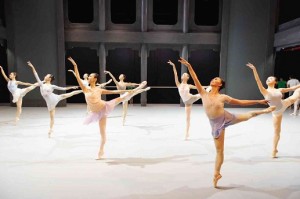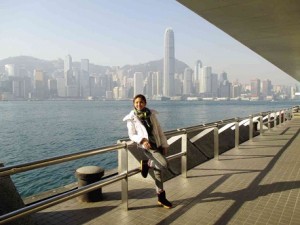Like most young persons working overseas for the first time, multiawarded ballerina and former Cultural Center of the Philippines’ principal dancer Candice Adea—now soloist of The Hong Kong Ballet—embraces every bit of the experience.

HONG KONG STAGE Candice (front right-hand corner) practices with members of The Hong Kong Ballet. Conrad Dy-Liacco
The novelty of searching and finding the right apartment in extremely expensive Hong Kong, commuting to class by bus, managing a monthly budget, has made independence a sweet sensation for the 27-year-old Candice. “Of course its difficult being alone, but I’m really enjoying myself,” she gushes during the interview.
Pirouetting away with the First Prize, Women’s Senior Division, at the Helsinki International Ballet Competition in 2010, Candice captivated Madeleine Onne, one of the judges and artistic directors of the 35-year-old Hong Kong ballet, who quickly got in touch with a contract.
Candice recalls: “It came at the right time as I had been with Ballet Philippines for 10 years, and much as I loved it, I felt I needed to go out and do new things. I grabbed the offer.”
She arrived in Hong Kong in October 2012 and effortlessly joined the productions, essaying roles such as the Courage Fairy in “Sleeping Beauty,” an Italian princess and a cygnet in “Swan Lake,” and Clara in “The Nutcracker,” among other roles.
Besides adapting to an alien metropolis, there are also over 40 company members from different countries—majority comprised of mainland Chinese— whose various cultural traits Candice has learned to be sensitive to. However, there is not much time to socialize. The sole Filipino in the group says: “Everyone goes to the studio, does their work and that’s it, and if they want to work some more, they stay after class. It all depends on the individual.”
With funding from the territory’s government and donations from passionate patrons, The Hong Kong Ballet is certainly luckier than a number of its counterparts in the region struggling to nurture a national balletic tradition and invest in its dancers. A steady stream of guest teachers, choreographers and stagers is a definite plus in Candice’s new work environment, and one that she intends to take full advantage of. A recent visiting artist was Nina Ananiashvili, the celebrated Russian ballerina and current artistic director of the State Ballet of Georgia. The group is currently working on her version of “Don Quijote.”
Ananiashvili, whom Candice describes as “very humble,” pushed her to “do more, jump more.”
But teachers, Candice quickly reminds us, are there ultimately to enhance a dancer’s style. “You are the professional, and are expected to know yourself and what works better for you. They share their expertise but it’s up to you to use it.”
Unlike in Manila, Candice now takes classes that start at 10 a.m., instead of 2 p.m. The venue on most days is a large rehearsal hall in the Hong Kong Cultural Centre, along the city’s spectacular harbor, except when a visiting troupe takes precedence. Then, the dancers are reassigned to a studio outside of the complex, which can prove tiresome given the gear they have to lug around. Lunch breaks are at 1:30 p.m., which, at times, are spent still perfecting a technique. Her day ends at 6 p.m., and with a more regular schedule, she tries to get her shut-eye before midnight.
In a city renowned for its rich and varied cuisine, Candice remains steadfast to a disciplined diet. “I love junk food and chocolates, but I know I have to control myself,” she says, adding that she does sneak in the occasional Big Mac. Her rigorous practice timetable leaves little time for playing the tourist, but she has managed to catch up with former Ballet Philippines members, several of whom are working with Disneyland Hong Kong.
Candice credits her older sister Carissa, one of Ballet Philippines’ three principal dancers, for leading her to her life’s work. “I’m the youngest in the family … the usual story, I wanted to get into whatever she was getting into—ballet, girl scouts.”
But it was as a 14-year-old during her first international competition in Japan that the immensity of the dance art dawned on her. “It suddenly dawned on me that what I was doing was my own real life. The dancers I saw performing made me realize the great things that we could do through dancing.
“I didn’t win that competition but I learned so much from the experience that I still felt that I had emerged a winner. I knew then I was going to make dance my career.”
Awards and accolades followed after that commitment, and no small ones at that. Besides the Helsinki plum in 2012, there was the Maris Liepa Award for Outstanding Artistry and Lead Role in Russian Ballet Performance Award at the Boston International Ballet Competition and the Bronze Medal at the Seoul International Dance Competition in 2011. What Candice regards as her proudest moment was landing the Silver Medal at the “Olympics of Ballet,” the USA International Ballet Competition senior women’s division in 2010.
That memorable event in Jackson, Mississippi, four years ago, the ballerina describes as a “suntok sa buwan experience (a long shot).” Candice, favorite partner Jean Marc Cordero (also her partner for real) and coach Victor Ursabia worked their blood and guts off to prepare their pieces, raising their own funds to get themselves to the competition. This was aside from still participating in the regular work of Ballet Philippines.
“We really didn’t expect anything. We just worked hard, and it proved to us that if you do work hard, you’ll be blessed,” says Candice.
Ballet Philippines is reportedly keen to participate in this dancing derby, held every four years in June, and intends to send three female dancers and one male dancer this year.
While Candice’s move to Hong Kong may be perceived as Philippine dance’s great loss, Hong Kong, if not the world, has gained an undeniable rising star. And one who is determined to reach her full potential. Says she: “I will do my job—push myself to whatever limit I can push myself. Everything will follow, I am sure of it. I leave it to fate.”



